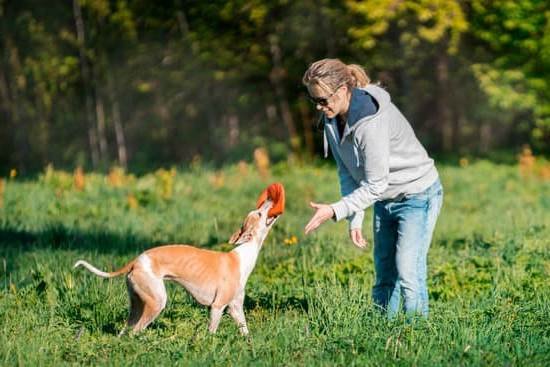Service dogs play a crucial role in improving the lives of individuals with disabilities, providing them with companionship, independence, and support. As the need for service dogs continues to grow, so does the demand for qualified and skilled service dog trainers. In this article, we will explore the steps and requirements involved in becoming a successful service dog trainer.
Service dogs are not just pets; they are highly trained professionals that assist individuals with disabilities in carrying out daily tasks and navigating their environments. From guiding individuals with visual impairments to alerting those with hearing loss, service dogs provide invaluable support and enhance the quality of life for their handlers.
With an increasing number of people seeking assistance from service dogs, there is a growing need for knowledgeable and experienced service dog trainers. These trainers play a vital role in preparing service dogs to fulfill their duties effectively, ensuring that they possess the necessary skills to meet the unique needs of their handlers.
In the following sections, we will delve into various aspects of being a service dog trainer. We will discuss what it takes to understand the role of a trainer, explore educational requirements and certifications needed for this profession, outline essential skills and qualities one must possess, dive into different training methodologies, provide practical tips for effective training sessions, address common challenges faced by trainers, touch upon ethical considerations, and explore potential career opportunities within this rewarding field.
Whether you have a passion for animals or aspire to make a difference in someone’s life through canine assistance, this article will serve as a comprehensive guide on how to become a successful service dog trainer. So let’s get started on this fulfilling journey towards helping others while working closely with amazing four-legged companions.
Understanding the Role of a Service Dog Trainer
Training service dogs is a rewarding and important role that requires dedication, patience, and a deep understanding of the responsibilities involved. Service dog trainers play a crucial role in improving the lives of individuals with disabilities by providing them with highly trained dogs that can assist with various tasks and provide support. In this section, we will explore the responsibilities and duties involved in training service dogs.
One of the primary responsibilities of a service dog trainer is to assess the needs of individuals with disabilities and determine what tasks the dog will need to perform to assist them effectively. This involves working closely with clients to understand their specific requirements and designing a training program tailored to their needs. Additionally, trainers must have expertise in selecting suitable dogs for service work, considering factors such as temperament, health, and breed characteristics.
Once the selection process is complete, trainers are responsible for implementing a comprehensive training plan that covers basic obedience commands as well as specialized tasks based on the individual’s specific disability. This may include teaching the dog to retrieve objects, open doors, turn lights on and off, or detect seizures or allergens. Trainers must have an in-depth understanding of positive reinforcement techniques and other effective training methods to ensure that the dogs learn these tasks reliably.
In addition to hands-on training exercises, service dog trainers also need to educate clients about how they should work with their service dogs once they are placed in their care. This includes teaching them how to reinforce learned behaviors through consistent practices while also maintaining appropriate boundaries between themselves and their working dog.
To summarize, being a service dog trainer involves assessing individual needs, selecting suitable dogs for service work, designing customized training programs that cover basic obedience commands as well as specialized tasks for individuals’ unique disabilities or requirements ,and educating clients about how to maintain appropriate behaviors once their assistance animal is placed into their care.
Education and Certification
To become a professional service dog trainer, it is important to have the appropriate education and certification. While there is no standardized educational path for this career, there are several options available to gain the knowledge and skills needed to excel in this field.
One option is to pursue a degree or certificate program specifically in service dog training or a related field. These programs often cover topics such as animal behavior, obedience training techniques, and disability awareness. Some universities and vocational schools offer these programs both online and on-campus, allowing individuals to choose the format that best fits their needs.
Another option is to complete an apprenticeship or mentoring program with an experienced service dog trainer. This hands-on experience can provide valuable practical training opportunities and insights into the profession. Many organizations that train service dogs offer apprenticeships or similar programs, providing a structured learning environment under the guidance of seasoned professionals.
In addition to formal education and apprenticeships, obtaining certifications can enhance credibility and demonstrate expertise in service dog training. The most recognized certification for service dog trainers is offered by the Certification Council for Professional Dog Trainers (CCPDT). The CCPDT offers various certifications based on experience level, including one specifically for service dog trainers. To qualify for certification, candidates must meet specific requirements such as a minimum number of hours working with dogs and passing a comprehensive exam.
Overall, pursuing education and certification in service dog training can provide aspiring trainers with the necessary knowledge and skills required to succeed in this rewarding career. Whether through formal education programs or hands-on apprenticeships, obtaining the appropriate credentials can help establish credibility and open doors to professional opportunities within the field of service dog training.
Developing the Necessary Skillset
Being a successful service dog trainer requires a unique set of skills and qualities. While it is important to have a genuine love for dogs, there are many other abilities and traits that are essential for excelling in this field. Here are some specific skills and qualities that one should possess in order to become a proficient service dog trainer:
- Knowledge of Dog Behavior and Training Techniques: A comprehensive understanding of canine behavior is crucial for effectively training service dogs. Trainers must be familiar with different training methods, such as positive reinforcement and clicker training, in order to modify behaviors and teach new commands. It is important to stay updated on the latest research and advancements in the field of dog training.
- Patience and Persistence: Training service dogs can be a lengthy process that requires patience, as each dog learns at its own pace. Trainers must be able to remain calm and composed during challenging situations, adapting their methods if necessary. Persistence is key when faced with setbacks, as trainers often encounter obstacles along the way.
- Excellent Communication Skills: Building a strong rapport with both dogs and clients requires effective communication skills. Trainers must be able to clearly convey instructions to dogs using verbal cues, body language, and other forms of nonverbal communication. Additionally, they should be able to communicate with clients in a compassionate manner, providing guidance, support, and appropriate feedback.
In addition to these skills, there are certain personal qualities that contribute to being an exceptional service dog trainer:
- Compassion and Empathy: Service dog trainers work closely with individuals who have disabilities or special needs. Demonstrating compassion towards both clients and their dogs creates a nurturing environment for everyone involved in the training process.
- Adaptability: Each client has unique requirements for their service dog based on their specific needs and lifestyle. A successful trainer must be able to adapt their training methods and techniques to meet individual client needs. Flexibility is also important in dealing with different dog personalities and temperaments.
- Strong Observational Skills: Being able to closely observe a dog’s behavior and assess their progress is essential for effective training. Trainers should have a keen eye for detail, being able to identify subtle changes in body language or behavior that may indicate the need for adjustment in training techniques.
By developing these skills and embodying these qualities, individuals can position themselves for success as service dog trainers. It is important to continually strive for personal and professional growth, seeking out opportunities for additional training and education in order to further excel in this rewarding field.
Choosing the Right Training Methodology
When it comes to training service dogs, there are a variety of training methodologies and techniques available. It is important for service dog trainers to carefully analyze these different methods in order to determine the most effective approach for their specific needs and the needs of the dogs they are working with.
One widely used training methodology in service dog training is positive reinforcement. This method involves rewarding desired behaviors with treats, praise, or other forms of positive reinforcement. By focusing on rewarding good behaviors instead of punishing bad behaviors, positive reinforcement creates a positive and enjoyable learning experience for the dog. This method is based on the principles of operant conditioning and can be highly effective in shaping desired behaviors.
Another training technique commonly used in service dog training is clicker training. Clicker training involves using a clicker to signal to the dog that they have performed a correct behavior, followed by a reward. The clicker serves as a marker that tells the dog exactly when they have done something right, making it easier for them to understand and learn. Clicker training can be particularly useful for teaching complex tasks or behaviors.
On the other hand, aversive-based methods such as punishment or corrections are generally discouraged in service dog training. These methods involve using physical force or intimidation to discourage undesirable behaviors. While they may produce quick results in certain situations, these methods can have negative effects on the emotional well-being of the dog and may damage the bond between the trainer and the dog.
It is important for service dog trainers to thoroughly research and educate themselves on different training methodologies before deciding which approach is best suited for their needs. Each method has its own pros and cons, and what works best for one dog may not work as effectively for another.
Trainers should also consider individual factors such as the temperament and personality of each specific dog they are working with. Ultimately, choosing the right training methodology requires careful consideration of various factors in order to ensure successful outcomes in service dog training.
| Training Methodology | Description |
|---|---|
| Positive Reinforcement | This method involves rewarding desired behaviors with treats, praise, or other forms of positive reinforcement to create a positive learning experience. |
| Clicker Training | This technique involves using a clicker to signal correct behavior and is useful for teaching complex tasks or behaviors. |
| Aversive-Based Methods | These methods involve using punishment or corrections to discourage undesirable behaviors but are generally discouraged in service dog training due to negative effects on the dog’s well-being and bond with the trainer. |
Building Relationships with Clients
Building strong relationships with clients is an essential aspect of being a service dog trainer. Clients who seek the assistance of a service dog trainer often have disabilities or special needs, and they rely on these trainers to provide them with the necessary skills and tools to improve their quality of life. Establishing trust, rapport, and effective communication is crucial for successful outcomes in service dog training.
The Importance of Trust and Rapport
When working with clients who require the assistance of a service dog, it is essential to build trust and establish rapport from the beginning. Many clients may have had negative experiences in the past or may be hesitant to rely on others for help. As such, it is important for service dog trainers to demonstrate professionalism, empathy, and understanding. This can help foster a positive relationship where clients feel comfortable expressing their needs and concerns.
Effective communication plays a critical role in building trust and rapport with clients. Service dog trainers must actively listen to their clients’ goals, preferences, and fears related to their service dogs. Regular check-ins should be conducted throughout the training process to address any concerns or questions that they may have. Open lines of communication will not only ensure that clients feel supported but also enable trainers to tailor their approach according to individual needs.
Understanding Individual Needs
Clients seeking the assistance of a service dog trainer often have unique requirements based on their disabilities or special needs. It is crucial for trainers to take the time to understand these individual needs thoroughly. By demonstrating genuine interest in understanding each client’s specific challenges and goals, trainers can develop personalized training plans that cater directly to those needs.
Additionally, it is imperative for service dog trainers to consider any emotional or psychological aspects related to their clients’ conditions. Some individuals may be dealing with trauma, anxiety disorders, or other mental health issues that can impact how they interact with both humans and animals. Therefore, trainers must possess strong interpersonal skills and knowledge of how various disabilities can affect a person’s behavior and emotions.
Overall, building relationships with clients in service dog training requires empathy, effective communication, and an understanding of individual needs. By establishing trust and rapport, trainers can develop strong connections with their clients, ultimately leading to successful outcomes in service dog training.
Practical Training Tips
Training a service dog requires a combination of patience, consistency, and positive reinforcement techniques. Here are some practical training tips to help you effectively train service dogs and teach them basic obedience commands as well as specialized tasks:
- Start with Basic Obedience Commands: Begin by teaching the dog essential commands such as sit, stay, come, down, and heel. Use clear verbal cues and hand signals consistently to reinforce these commands. Reward the dog immediately with treats or praise when they respond correctly.
- Build Positive Associations: Create positive associations with the training process by making it fun for the dog. Incorporate playtime and rewards into their training sessions to keep them engaged and motivated. Remember, positive reinforcement is key to successful training.
- Gradually Introduce Distractions: Once your service dog has mastered basic obedience commands in a controlled environment, gradually introduce distractions to their training sessions. This will help them learn to focus on their tasks despite external stimuli such as noises or other people.
- Task-Specific Training: Depending on the specific needs of the individuals they will be assisting, service dogs may require specialized tasks such as retrieving items, opening doors, or alerting to medical conditions. Break down these tasks into smaller steps and use shaping techniques to guide the dog through each step until they can perform the task reliably.
- Socialization: Ensure that your service dog is well-socialized from an early age by exposing them to various environments, people, animals, and situations. This will help them remain calm and confident while performing their duties in public settings.
Remember that every service dog is unique, so tailor your training methods to suit each individual dog’s temperament and abilities. Consistent practice, reinforcement of positive behaviors, and regular maintenance training are essential for maintaining a well-trained service dog.
By following these practical training tips, you will be on your way to becoming an effective service dog trainer and helping individuals with disabilities lead more independent lives.
Dealing with Challenges and Obstacles
Becoming a service dog trainer is a rewarding career, but it is not without its challenges. As a service dog trainer, you will encounter various obstacles throughout your training journey. However, with the right strategies and mindset, these challenges can be overcome successfully.
One of the most common challenges that service dog trainers face is working with dogs who have behavioral issues or limited trainability. These dogs may exhibit fear, aggression, or other challenging behaviors that make the training process more difficult.
In order to address this challenge, it is crucial for trainers to have a deep understanding of canine behavior and learning theory. By identifying the underlying causes of these behaviors and implementing personalized training plans tailored to each dog’s needs, trainers can help modify these behaviors effectively.
Another challenge that service dog trainers may encounter is managing client expectations and ensuring effective communication between clients and trainers. It is important to remember that clients often have high hopes for their service dogs and may become frustrated when progress is slower than expected. To overcome this challenge, effective communication skills are essential.
Trainers should establish clear expectations from the beginning and maintain open lines of communication throughout the training process. Regularly updating clients on progress, involving them in the training process whenever possible, and offering support and guidance can help build trust between trainers and clients.
In addition to working through behavioral challenges and managing client expectations, service dog trainers must also navigate ethical dilemmas that may arise during their work. This includes ensuring proper treatment of both dogs and clients, as well as following legal obligations under the Americans with Disabilities Act (ADA).
Trainers must prioritize the welfare of both dogs and clients above all else. It is important to constantly evaluate your own practices to ensure they align with ethical guidelines while providing effective training methods.
By staying informed about current research in canine behavior, consistently improving communication skills, and maintaining high ethical standards, service dog trainers can successfully overcome the challenges they may face. Remembering that every challenge presents an opportunity for growth and learning will ultimately contribute to a more successful training experience for both trainers and the service dogs they work with.
Ethics and Legal Considerations
Being a service dog trainer comes with certain ethical guidelines and legal obligations that must be followed in order to ensure the welfare of both the dogs being trained and the individuals who rely on them. One of the key legal considerations that service dog trainers must adhere to is compliance with the Americans with Disabilities Act (ADA).
The ADA prohibits discrimination against individuals with disabilities and requires reasonable accommodations for their inclusion in public spaces, including allowing them to be accompanied by service dogs.
Service dog trainers must ensure that their training practices align with the principles outlined in the ADA. This includes providing proper guidance and support to elevate the professional standards of service dogs. Trainers should always prioritize the well-being and safety of both the dogs and their future handlers, as failing to meet these expectations can have serious consequences.
In addition to complying with legal obligations, service dog trainers must also adhere to ethical guidelines. This involves treating all clients fairly, respecting their privacy, and maintaining professionalism at all times. It is essential for trainers to recognize their own limitations and not promise outcomes or results that they cannot guarantee. Furthermore, trainers should practice transparency when it comes to fees, contracts, and any potential conflicts of interest.
By following ethical guidelines and meeting legal obligations, service dog trainers not only maintain a positive reputation within the industry but also ensure that individuals relying on service dogs have access to reliable assistance animals. Ensuring compliance with ethical standards ensures that service dogs are properly trained and equipped to perform necessary tasks while providing emotional support for those in need.
Career Opportunities and Growth
The field of service dog training offers a range of career opportunities and the potential for growth and advancement. As the demand for service dogs continues to increase, so does the need for skilled and certified trainers. This article has provided valuable information on how to become a service dog trainer, exploring the responsibilities, educational requirements, and necessary skillset.
For those considering a career in service dog training, it is important to understand the various paths available within this field. Service dog trainers can work in different settings such as private training organizations, non-profit organizations, or even start their own training business.
They may specialize in training dogs for specific tasks such as mobility assistance, medical alert, or autism support. By focusing on a particular area of expertise, trainers can further develop their skills and knowledge in order to better serve their clients.
In terms of professional growth and advancement, continued education and networking are key strategies. Staying updated on the latest research and advancements in dog training techniques is crucial for offering the best services to clients.
Pursuing certifications from reputable organizations can also demonstrate one’s commitment to professionalism and expertise in the field. Furthermore, building relationships with other professionals such as veterinarians or therapists who work with individuals in need of service dogs can lead to referrals and collaborations that enhance both personal growth and business opportunities.
In conclusion, becoming a service dog trainer requires passion, dedication, and an understanding of the significant role these dogs play in improving people’s lives. By following the outlined steps in this article, aspiring trainers can take their first steps towards a rewarding career helping individuals with disabilities gain independence through trained service dogs.
With ample career opportunities available within this growing field, combined with continuous learning and networking efforts, professionals can expect a fulfilling and successful journey as service dog trainers.
Frequently Asked Questions
How do I make a career out of dog training?
Making a career out of dog training requires a combination of education, experience, and a passion for working with dogs. To start, it is important to gain knowledge and skills in dog behavior, obedience training techniques, and positive reinforcement methods. This can be achieved through formal education like attending a dog training school or obtaining certifications from reputable organizations.
Practical experience is also crucial, as hands-on work with various breeds and temperaments of dogs will enhance your abilities and understanding. Building a network by connecting with other professional dog trainers or joining industry associations can provide valuable opportunities for mentorship and career growth. Additionally, marketing yourself through online platforms or establishing your own dog training business can help attract clients and establish credibility within the industry.
How do you qualify for a service dog in Texas?
In Texas, qualifying for a service dog involves meeting certain criteria set by the Americans with Disabilities Act (ADA). The ADA defines individuals with disabilities as those who have physical or mental impairments that substantially limit one or more major life activities. To qualify for a service dog in Texas or any other state, an individual must have a disability recognized under the ADA.
Moreover, they must be able to demonstrate that the service dog is trained specifically to perform tasks directly related to their disability. These tasks may include alerting them to sounds or alarms, guiding them during mobility assistance, or detecting medical conditions like seizures or diabetic emergencies. It is essential to consult the ADA guidelines and work closely with healthcare professionals to determine eligibility for a service dog in Texas.
How to catch a fake service dog?
Recognizing fake service dogs can be challenging but there are several indicators that might help identify them. True service dogs are highly trained animals that display impeccable behavior in public spaces – they remain calm, well-behaved, and completely focused on assisting their handler’s needs without causing disruption or harm to others. Fake service dogs often lack this level of training and discipline – they might exhibit unruly behavior like barking excessively, jumping on people, disregarding commands, or showing aggression.
Additionally, legitimate service dogs wear specific equipment like harnesses or vests to easily identify them as working animals. Individuals claiming their pet as a service dog without proper documentation or proof of training should be seen as potential red flags. Educating ourselves and reporting suspected cases of fake service dogs to the relevant authorities can help preserve the integrity and accessibility of genuine service dog partnerships for those in need.

Welcome to the blog! I am a professional dog trainer and have been working with dogs for many years. In this blog, I will be discussing various topics related to dog training, including tips, tricks, and advice. I hope you find this information helpful and informative. Thanks for reading!





